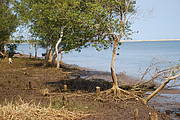A big YES to mangroves, but where and how?
13 September 2012 | Article
Mangroves reduce wave height by as much as 66% over 100 metres of forest. A new report by The Nature Conservancy and Wetlands International says that mangrove management needs to be included in climate change adaptation and disaster risk reduction efforts in coastal areas worldwide.
Waves are most rapidly reduced when they pass through a greater density of obstacles. This means that mangroves with aerial roots reduce waves in shallow water quicker than those without. IUCN spoke to Mark Spalding, TNC Senior Marine Scientist, about the importance of natural barriers and what is being done.
A number of characteristics of mangroves directly affect the rate of reduction of wave height, most notably due to the physical structure of the trees. The effects of waves are minimalized as they pass through more obstacles.
The report points out that coastal engineers have started modelling the passage of waves through mangroves to understand the level of protection provided and to plan how to increase it.
While there is a general consensus that mangroves can reduce wind and swell waves, research has focused on small waves. There is a need to measure the reduction of larger wind and swell waves associated with greater water depths, which may occur during storms and cyclones.
Coastal wetlands, such as mangrove forests, greatly contribute to the safety, food security and income of tens of millions of people throughout the tropics. It is important to conserve them and to continue studying where and how mangroves can really act as barriers against extreme events.
The report brings together the latest scientific research from leading engineers and ecologists on coastal protection against waves.It was produced in strong collaboration with Wetlands International, working both in the Netherlands and Indonesia. Also with government and private sectors, including the US Army Corps of Engineers and with Deltares – two of the world’s leading organisations in coastal protection engineering.
The first of the new reports on mangroves and coastal protection can be downloaded from www.naturalcoastalprotection.org.
McIvor, A.L., Möller, I., Spencer, T. and Spalding. M. (2012) Reduction of wind and swell waves by mangroves. Published by The Nature Conservancy and Wetlands International. 27 pages.






